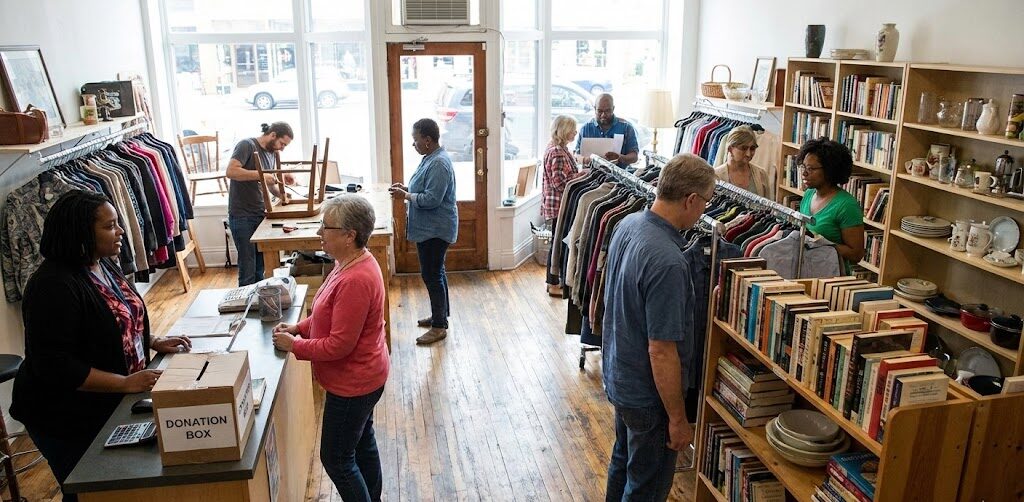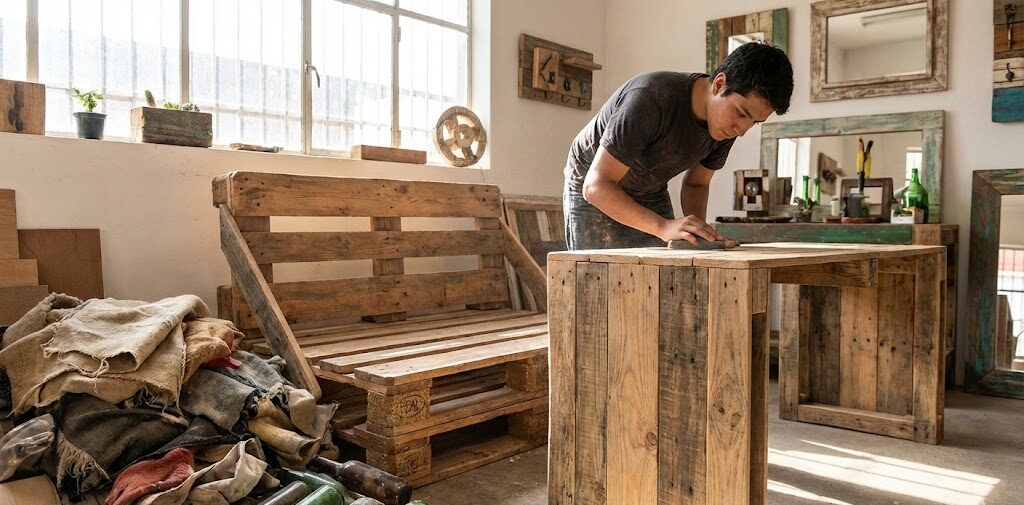
Thrift shopping is a practical way to stretch your budget, reduce financial stress, and make a positive impact on your community and the environment. Here’s why it works:
- Big Savings: Thrift stores offer items at up to 50% or more off retail prices. A $165 pair of jeans can cost under $20, and a $1,500 designer coat might sell for $6.
- Budget Relief: Families can afford essentials like clothing, furniture, and household items without overspending, freeing up money for other priorities, such as debt or savings.
- Community Support: Many thrift stores fund local programs, create jobs, and help organizations like Disabled American Veterans (DAV).
- Eco-Friendly: Buying secondhand reduces waste, lowers demand for new production, and extends the life of usable items.
How Thrift Shopping Cuts Financial Stress
Thrift shopping takes the edge off financial worries by offering everyday essentials at prices that are much easier on the wallet. It’s not just about saving money – it’s about creating room in your budget for other priorities. The moment you snag an affordable item, you’re changing the way you approach spending.
Affordable Finds for Families
Thrift stores make it possible to pick up clothing, household items, toys, and even furniture without breaking the bank. Take, for example, a project manager who scored a $20 leather tote bag with a laptop sleeve or a cartoonist who landed a $6 designer coat originally priced at $1,500. Stories like these are common in the world of thrift shopping.
What’s the secret? Thrift stores often carry items of the same quality you’d find in regular retail shops – but at a fraction of the cost. And if you shop smart, you can save even more. Look for discount days or shop off-season to snag clothing at incredibly low prices. Savvy shoppers also use their phones to check the value of items and take their time inspecting potential purchases.
Easing Financial Stress
For families feeling the pinch, thrift shopping offers real relief. When essential needs are met at affordable prices, it frees up cash for other priorities – whether that’s building an emergency fund, paying off debt, or just giving your budget some breathing room.
“Thrift stores and garage sales are a way to get clothing and other things for a fraction of the price. It helps your money go farther versus paying full price. Especially now with grocery prices so high and gas too.” – Shannon Coble, Author
This approach is already gaining traction, especially among millennials. They tend to spend less on clothing each month compared to Gen X, likely because of their embrace of thrift shopping. What’s more, this isn’t just a one-time fix – it’s a long-term strategy. Regular thrift shopping can stretch a family’s budget over time, reducing financial strain and encouraging better financial choices.
Supporting the Community and the Planet
Thrift shopping isn’t just good for your wallet – it also benefits your community and the environment. Every purchase contributes to local programs and causes, transforming a simple shopping trip into an act of community support. Many thrift stores channel their profits into essential neighborhood services.
“When you think about thrift shops, it’s recycling something that’s still in good quality to allow someone else the opportunity to continue taking advantage of that product at a reasonable price, and that income we make is going back to a good cause.” – Keith Stinson, Board President of Chatham PTA Thrift Shop
On top of that, buying secondhand reduces waste and extends the lifespan of items. By choosing thrifted goods, families lower the demand for new production, which in turn helps the environment.
This combination of financial savings, community support, and environmental responsibility makes thrift shopping much more than a budget-friendly choice. It’s a way to contribute to something bigger – strengthening your community while making sustainable, mindful decisions.
Tips for Getting the Best Deals at Thrift Stores
Scoring amazing finds at thrift stores isn’t just about luck – it’s about strategy. Knowing when to shop, how to budget, and what to prioritize can help you stretch your dollars while uncovering hidden treasures.
Best Times to Shop for Deals
Timing is everything when it comes to thrift shopping. Monday and Tuesday mornings are prime times to visit because many people donate over the weekend, giving stores time to sort and stock new items. This means you’ll often get first pick before the crowds arrive.
Mid-week is another sweet spot. Many thrift stores offer mid-week discounts to draw in shoppers during slower periods. Early morning visits often yield the best selection, while some stores slash prices later in the day to clear out inventory.
Be on the lookout for colored tag sales. These discounts rotate by tag color, so you might snag a $10 item for just $2. Additionally, holiday seasons and spring cleaning months usually bring in a surge of donations, leading to more frequent restocking.
Want an insider edge? Ask the staff about restocking schedules and special discount days. Most employees are happy to share tips that could save you money. Many thrift stores also post sale calendars and updates on their websites or social media pages, so it’s worth checking before you go.
Once you’ve nailed down the best times to shop, head in with a clear plan and budget.
Smart Shopping and Budgeting
While timing helps you find great deals, sticking to a budget ensures you don’t overspend. It’s easy to go overboard when everything feels like a bargain, so bring cash or set a firm spending limit to keep yourself in check. Paying with cash is also a simple way to track your spending.
Start each trip with a list of what you need. This keeps you focused and helps avoid impulse buys. If you see something tempting, ask yourself: Will I actually use this? Does it fit with what I already own?
Pay attention to quality. Look for durable materials like stainless steel, cast iron, porcelain, and real leather. For clothes, stick to natural fibers like cotton, wool, and silk, and inspect stitching and seams to ensure the item is well-made.
“There is nothing like the feeling of finding the perfect 100 percent wool, mock neck sweater that’s been made in England for $8 – which just happened the other week”, says Shannon Wissler, co-founder of Ella Jane Vintage.
Don’t forget to sign up for loyalty programs at your favorite thrift stores. Many offer perks like coupons, rewards, or early access to sales. Learning how the store’s color tag system works can also help you score extra discounts.
Consistency plays a big role in thrift shopping success, as we’ll explore next.
Shopping Often and Being Patient
Frequent visits are key to finding the best deals. The more often you shop, the better you’ll get at spotting quality items and understanding how each store operates.
Use tools like Google Lens on your phone to check an item’s value on the spot. This free app can help you identify hidden gems and research their worth before making a purchase.
Building relationships with store staff can also pay off. Employees often know when new donations arrive and might even tip you off about items that match your interests. Some seasoned thrifters go a step further and ask staff to keep an eye out for specific pieces they’re hunting. Regular visits not only improve your thrift game but also strengthen your ties to the community.
Planning Your Thrift Shopping Trips
A successful thrift shopping trip starts long before you set foot in the store. A little preparation can turn a chaotic hunt into a focused, budget-friendly adventure. Knowing what you need, bringing the right company, and understanding how to navigate the store will make your trip far more rewarding.
Making a Shopping List
Walking into a thrift store without a plan is like diving into a sea of options without a compass. It’s easy to get overwhelmed, miss great finds, or end up buying things you don’t need. That’s where a thrifting wishlist comes in handy – it keeps you focused on what really matters. Think about those items you’ve been eyeing online or that have been sitting in your Amazon cart for weeks.
Jot down your priorities: maybe it’s a specific piece of furniture, versatile home decor, or a rare collectible. Visual aids like inspiration boards or saved photos can also help. For example, if you’ve been dreaming of a mid-century modern lamp or a unique ceramic bowl, having a reference makes spotting the right piece much easier. This approach turns random browsing into a purposeful treasure hunt.
Shopping with Family or Friends
Thrifting is more than just shopping – it’s an experience, and bringing along family or friends can make it even better. Not only does it add a social element, but having an extra set of eyes can help you spot hidden gems that you might otherwise miss.
“Shopping with a friend can help reduce anxiety, provide a second set of eyes for observation, and make the experience more enjoyable. It can also help assess potential purchases.” – BestMark
Your companions can also help you stay grounded. That vintage jacket might look amazing on the rack, but a trusted friend can give you an honest opinion about the fit or color. Sharing your wishlist ahead of time is another smart move. If you’re busy in one section, a friend can keep an eye out for items on your list, ensuring nothing gets overlooked.
Learning Store Layouts and Getting Staff Help
Familiarizing yourself with a store’s layout can save you loads of time, especially on future visits. Most thrift stores organize items by category – clothing by size and gender, housewares separate from books and electronics. Some even have specialty sections, like a designated vintage area, so you’ll know exactly where to head for specific finds.
Don’t underestimate the value of the store staff. They’re a goldmine of information. Employees often know when new donations arrive, which days have the best selection, and where the hidden treasures are. Building a friendly relationship with staff can give you a real edge – sometimes they’ll even tip you off about items that are about to hit the floor.
It’s also worth asking about store policies and discounts. Staff can explain how color tag systems work, when markdowns happen, and whether there are loyalty programs or special shopping hours. Knowing these details helps you time your visits for the best deals and ensures you shop as efficiently as possible.
Community Impact: Shopping at Red Racks Thrift Stores
Shopping at Red Racks Thrift Stores isn’t just about finding great deals – it’s about making a difference in Missouri communities. Since 1958, this veteran-owned organization has been creating positive change across the state, offering benefits that stretch far beyond saving money.
Supporting Disabled American Veterans
Every purchase at Red Racks helps support Disabled American Veterans (DAV), a nonprofit dedicated to assisting veterans nationwide. As a DAV-owned and operated organization, Red Racks channels your purchases and donations into funding critical programs. For example, in 2021, DAV provided over 163,000 rides for medical and VA appointments and helped with more than 151,000 benefit claims, securing over $25 billion in disability benefits for veterans. Beyond that, DAV offers lifelong support to veterans and their families, including assistance with VA benefits, transportation for medical care, job placement, and help transitioning to civilian life. Donating gently used items not only supports this mission but also helps declutter your home while making a meaningful impact.
Helping the Planet
Shopping at Red Racks also makes an environmental difference. By choosing secondhand items, you reduce the demand for new production, which helps lower the carbon footprint of the fashion industry. Red Racks takes its commitment a step further by recycling unsold goods locally within Missouri, ensuring that usable items stay in circulation. Donating your unwanted items gives them a second life, reduces landfill waste, and supports veterans – all in one thoughtful act.
Affordable Shopping and Job Opportunities
In addition to supporting veterans and the environment, Red Racks provides budget-friendly shopping options and creates local job opportunities. The stores offer affordable prices that help families manage tight budgets while contributing to the community’s economic stability. While employee experiences may vary, many workers find purpose in knowing their efforts directly benefit veterans. Every purchase not only stretches your dollar but also strengthens the local economy and supports veteran welfare, making thrift shopping a win-win for everyone involved.
Making Thrift Shopping Part of Your Budget Plan
Thrift shopping offers a practical way to stretch your finances while positively impacting your community and the planet. On average, thrift store shoppers save nearly $150 per month, which translates to about $1,760 a year. That extra cash can go toward paying off debt, building an emergency fund, or investing in your family’s future.
To make thrift shopping a regular part of your routine, start by setting a monthly thrift budget that balances your needs and wants. Financial expert Trae Bodge emphasizes the long-term value of this habit, saying, “If you teach your kids early that buying secondhand is a good thing, you will get them on board to do it”. This mindset not only improves financial well-being but also instills smart spending habits in the next generation.
Beyond financial perks, buying secondhand helps reduce textile waste and cut down on carbon emissions. Shopping at places like Red Racks goes a step further by supporting organizations like Disabled American Veterans and strengthening local communities.
Consistency and patience are key to making thrift shopping work for you. Visit thrift stores regularly – weekday mornings are often the best time to find fresh inventory. With the resale market growing 21 times faster than traditional retail, there’s never been a better time to embrace secondhand shopping as part of your lifestyle.
FAQs
What are the best ways to save money and find great deals while thrift shopping?
Thrift shopping can be a great way to save money and score some amazing finds, but timing plays a big role. Try visiting thrift stores early in the week, like Monday or Tuesday mornings. That’s often when new items hit the shelves, giving you first dibs on fresh inventory. Also, keep an eye out for special promotions like color tag discounts or midweek sales – these can help you save even more.
Making thrift shopping a regular habit can boost your chances of discovering unique, high-quality items at unbeatable prices. When you’re browsing, take a moment to inspect items closely for quality and functionality. This ensures you’re getting the best value for your money. With a little strategy and attention to detail, thrift shopping can help you stretch your budget while uncovering some real gems.
How does thrift shopping benefit the environment and local communities?
Thrift shopping is a smart way to help the planet. It cuts down on waste, saves resources, and reduces pollution. When you buy secondhand clothing, toys, or household items, you’re giving them a second chance instead of letting them end up in landfills. Plus, this reduces the demand for new production, which helps lower greenhouse gas emissions.
But it’s not just about the environment – it’s about people too. Thrift shopping supports local communities by creating jobs and funding charitable programs. It also promotes a circular economy, where items are reused instead of thrown away. Stores like Red Racks Thrift Stores play a big role by offering budget-friendly shopping options and reinvesting in the community. It’s a win-win for both the planet and the people who live on it.
How can I use thrift shopping to save money and manage my budget effectively?
Thrift shopping is a great way to save some cash while easing financial pressure. To get started, set a monthly spending limit – something like $20 to $50 – to keep your budget on track. Before heading out, jot down a list of what you actually need. This helps you avoid those tempting impulse buys.
Keep an eye out for sales, discounts, or off-season deals to stretch your dollars even further. Aim for gently used, well-made items that will hold up over time, giving you more bang for your buck. Shopping at places like Red Racks Thrift Stores not only keeps your wallet happy but also supports local communities and eco-friendly practices.





